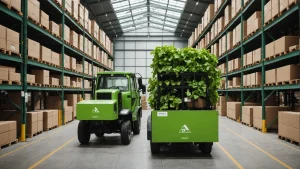In 2024, a quiet revolution is reshaping the business landscape. It’s not flashy tech or viral marketing. It’s green logistics, and it’s transforming how small businesses operate, compete, and thrive.
Most small business owners are leaving money on the table. They see green practices as a luxury, a “nice-to-have” for when business is booming. They couldn’t be more wrong.
Benefits of green logistics for small businesses: Green logistics isn’t just about saving the planet (though that’s a nice bonus). It’s about saving your business. It’s about cutting costs, boosting efficiency, and winning customers in ways your competitors haven’t even considered.
Ready to turn your supply chain into a lean, green, profit-generating machine? Buckle up. We’re about to show you how green logistics strategies can transform your small business from a survivor to a thriver in 2024 and beyond.
The future of small business success is green. Are you ready to claim your share?

Metrobi drivers are rated 4.97 out of 5
Trusted by local businesses for:
- Background-checked professionals
- Specialized in business deliveries
- Same drivers for consistency
- 4.97/5 average delivery rating
Benefits of Green Logistics for Small Businesses: What is Sustainable Supply Chain Management?
-
Sustainable supply chain management lowers waste, emissions, and costs.
-
Uses recycled materials and energy-efficient transport to reduce environmental impact.
-
Includes concepts like reverse logistics and green suppliers networks.
Definition and Concept
Sustainable supply chain management involves integrating green practices into supply chains to improve environmental outcomes. This approach targets minimizing waste, emissions, and costs. Key areas include energy-efficient transport and choosing sustainable materials. The concept of sustainable shipping focuses on using resources responsibly, shrinking carbon footprints, and ensuring long-term supply chain viability. Consider adopting eco-friendly retail strategies in 2024 to lessen ecological impacts and appeal to environmentally aware shoppers.
Example(s) of Sustainable Practices
Using recycled materials in packaging can drastically cut down on resource use. For instance, companies like Unilever have pledged to halve their use of virgin plastic by 2025. This not only reduces the environmental footprint but also appeals to increasingly eco-conscious consumers.
Choosing transport options that use less fuel is another key practice. Electric vehicles in logistics fleets are gaining traction as they offer long-term savings on fuel and maintenance. For example, logistics giant DHL has invested heavily in electric vans and bikes, significantly cutting emissions in urban deliveries.
Types of Sustainable Supply Chains
Green Suppliers Network
A green suppliers network involves working with suppliers who prioritize sustainability. Evaluation metrics for suppliers now often include energy usage, waste, and emissions. Businesses like Walmart implemented a sustainability index measuring suppliers’ green practices, helping to foster a more eco-friendly supply chain.
Reverse Logistics
Reverse logistics manages the reuse of products. It involves processes like returns, refurbishing, and end-of-life product recycling. This system reduces waste volume, cuts disposal costs, and even generates revenue from reselling used products. Harvard Business Review discusses how companies like Dell have embraced reverse logistics to refurbish old equipment, thus reducing their e-waste.
Arguments For and Against
Sustainable supply chains can lead to cost reductions, compliance with regulations, and improved brand reputation. For instance, supply chain transparency helps companies like Patagonia showcase their commitment to sustainability and boost customer trust.
On the downside, adapting current supply chains to a sustainable model can be expensive and time-consuming. Companies may need to invest in new technologies or training, which can strain resources. Another issue lies in the complexity of aligning multiple stakeholders in a supply chain to follow green practices, as revealed by studies in the Journal of Business Logistics.
Key Business Benefits from Green Logistics Practices
-
Cut costs by reusing packaging and optimizing transport.
-
Shrink your carbon footprint with renewables.
-
Boost public image and customer loyalty with eco-efforts.
Cost Savings Through Eco-Friendly Practices
Reusing materials can save a lot of money. Big manufacturers show us how. General Motors saves $12 million every year. They use a reusable container program with partners. Small businesses can follow this lead. You can use materials more than once to cut costs and waste.
Cutting down carbon and costs can happen all at once. Route optimization can cut global greenhouse gas emissions by 20% and fleet efficiency by 30%. This is significant. Tools like GPS and advanced software help plan better paths. Less fuel burned means more money saved.
Some argue the setup cost for these technologies is high. Others see this as a small price for bigger long-term savings. For a deep dive into tech-driven logistics, check out “Designing and Managing the Supply Chain.” It discusses supply systems and strategic road mapping.
Reducing Carbon Footprint in Small Businesses
Decrease in Greenhouse Gas Emissions from Logistics
The logistics sector is a heavy emission contributor. It makes up 17% of global greenhouse emissions. Small businesses play a part too. By focusing on their eco-friendly logistics practices, reductions can happen. Decreasing these numbers comes with obvious environmental and financial perks.
The pros are less pollution and lower costs. However, the switch to green methods can be complex. DSV highlights a need for sustainable trade practices, urging businesses to adapt for a better future.
Adoption of Renewable Energy Sources in Operations
Stepping towards solar and wind in operations saves more than energy. Amazon’s centers using renewables cost 10% less than using fossil fuels. This isn’t just eco-friendly; it’s cost-efficient too.
However, the upfront investment can be a concern for smaller firms. Yet, with time, the paybacks are clear. The savings gained and brand value makes the switch worthwhile.
Enhancing Brand Image with Green Logistics
Positive Public Perception by Promoting Sustainability Efforts
Having a green agenda can make a company more appealing. A large number of consumers lean towards sustainable products. Having a practice that aligns with this can be a solid market move.
Many small businesses find it worth the initial investment. It brings in new customers and keeps the current ones. How does this shift in perception impact sales? Studies show it leads to improved market standing and increased revenue streams.
Increased Customer Loyalty from Socially Responsible Practices
Social responsibility attracts loyalty. Customers today care about where their goods come from and how they reach them. Businesses with sustainable practices build trust.
Steven Liu, a VP at Legrand, stresses the importance of understanding the full lifecycle of products. Green logistics reshapes how companies engage with the supply chain. This attracts a new wave of customers who value responsibility.
How do Green Logistics Work?
Core Components
Green logistics starts by using eco-friendly technologies. This includes alternatives like electric vehicles, solar-powered warehouses, and recycling systems. These technologies reduce emissions and waste, benefiting both the environment and the company’s bottom line. For instance, many logistics companies deploy electric fleets to cut down on carbon output, reducing greenhouse gas emissions. This shift is not just a trend. It’s becoming a standard practice as businesses respond to customer demand for sustainability. 70% of online shoppers consider sustainability when they make buying choices. They don’t mind waiting longer for their goods if it helps the environment.
Designing Eco-efficient Transportation Networks
Developing transportation networks that are eco-efficient is crucial. This means optimizing delivery routes and using fuel-efficient vehicles. Technologies like AI and IoT can help plan these routes, saving fuel and time. A well-designed network reduces congestion and supports emission targets. A good example is the ORION tool used by UPS. This system cuts down unnecessary miles, thus trimming emissions. By doing so, companies save on fuel costs and improve delivery times, enhancing customer satisfaction.
Step-by-Step Process
Step #1 Conducting an Environmental Audit
-
Assess Current Logistics Emissions and Waste: You should start by measuring your company’s current carbon footprint. Use tools that help pinpoint waste areas in the logistics process. This gives a baseline for improvement. Look into factors like fuel consumption, packaging waste, and emissions from warehouses.
-
Set Benchmarks for Improvement: Once you know the current state, define what improvements look like. Whether it’s reducing fuel consumption by 10% or lowering packaging waste by 20%, you should set clear, measurable goals. These benchmarks help track progress and make necessary adjustments.
Step #2 Developing a Sustainability Plan
-
Establish Clear Sustainability Goals: Map out what your company aims to achieve with green logistics. Do you want to cut emissions or perhaps switch to renewable energy sources? Whatever goals you choose, ensure they’re aligned with your larger business objectives.
-
Choose Eco-friendly Suppliers and Transport Modes: Next, you should select suppliers who follow green practices. These could be companies with electric vehicle fleets or those that use sustainable materials. If possible, find transport modes that emit less CO2, like trains or electric trucks.
Step #3 Implementing the Plan
-
Roll Out New Procedures and Technologies: You can start implementing the changes defined in your plan. Install new technologies and adjust procedures to be more eco-friendly. Monitor these implementations closely to make sure they’re improving efficiency and reducing waste as expected.
-
Train Staff on Sustainable Practices: It is better to inform and train employees about the new green practices. They need to understand the importance of sustainability in logistics. Employee engagement is crucial for seamless execution. Hold workshops or training sessions to bring everyone on board.
By following these steps, businesses can better understand and adopt green transportation and logistics practices. This shift not only suits consumer demands but also boosts profits. Adopting zero- and low-waste policies can enhance operating profits by up to 60%.
5 Strategies to Optimize Green Logistics in Small Businesses
Leverage Technology for Route Optimization
Using tech to make logistics operations map out routes can cut costs and emissions. GPS tools and data analytics offer real-time insights that help decide the best paths for delivery. More efficient routes mean fewer miles driven and less fuel used.
Using real-time data involves a continuous loop of collection, analysis, and adjustment. This loop allows businesses to react fast to issues like traffic jams or accidents. This approach, known as dynamic route optimization, can make small changes that significantly impact fuel consumption.
Partner With Eco-Friendly Suppliers
Choosing suppliers with green credentials is crucial. It’s not just about materials; it’s about shared goals. Engaging in initiatives helps both parties benefit. You can consider a small business that partners with a supplier practicing zero waste. This partnership lowers costs and reduces environmental impact.
While eco-friendly suppliers might seem costlier upfront, the long-term benefits often outweigh the immediate expenses. The relationship sets the foundation for both financial savings and more sustainable future operations.
Maximize Load Efficiency
Load efficiency means doing more with less. This strategy focuses on how much cargo one vehicle carries at a time. Unfortunately, many transport vehicles run less than full. Increasing fill rates reduces the number of trips, saving fuel and time.
Tech-like load optimization software examines cargo dimensions to find the best loading method. The more efficient the load, the fewer the trips. This efficiency pushes small businesses toward reduced carbon emissions and costs over time.
Invest in Renewable Energy
Shifting to renewable energy can cut long-term costs. Installing solar panels or wind turbines aids companies in decreasing fossil fuel reliance businesses reduce it. Initially, the investment might seem high, but over time, energy savings balance it out.
“A Bright Future: How Some Countries Have Solved Climate Change” offers insight into the global shift toward renewables. Businesses stand to benefit from government incentives that make renewable investments worthwhile. While the startup costs of going green can be high, many businesses find the investment in solar or wind energy pays off in a few years.
Keep an eye on technological advancements. Emerging tech in renewable energy can lower costs and improve energy efficiency, even further.
Monitor and Share Progress
Regular progress evaluation is important. Tracking performance via key metrics helps businesses fine-tune strategies. Sharing these metrics with stakeholders also promotes transparency and engagement.
For ongoing measurement, consider ISO 14001, an international standard for EMS. This standard can guide businesses in setting up an environmental management system. The book “Eco-Innovation” discusses how transparency in green practices can boost a brand’s reputation. By sharing success stories, businesses engage customers and demonstrate commitment to adopting sustainable practices.
Using feedback loops allows businesses to adjust plans quickly. This versatility helps companies meet sustainability goals while maintaining business efficiency.
These environmentally conscious strategies demand an investment of time and resources. Yet the benefits — cost savings, improved reputation, and reduced environmental footprint — can significantly impact a business’s bottom line.
What is the Best Approach for Small Business Green Logistics?
Evaluate Company Size and Logistics Needs Before Choosing a Strategy
Understand Your Business Size and Scale
Kick-off by gauging your company’s size. A tight budget and small team mean different options from a large corporation. Small outfits have to be careful about resource allocation. You should decide how much you can invest in implementing green logistics without straining your resources. This step lets you know if you have room to adopt eco-friendly practices.
Assess Your Specific Logistics Needs
Dig into what your business needs in terms of sustainable logistics. Are there areas ripe for improvement? Start with your supply chain and identify pain points. Do you need to cut emissions, or figure out better routes? This step is crucial because it helps point decision-making in the right direction. 70% of online shoppers care about sustainability when buying. Aligning your logistics with consumer expectations can boost customer satisfaction.
Test and Measure the Impact of Various Eco-Friendly Practices
Begin with Simple Initiatives
You should start small. Implement minor changes first. It is better to use sustainable eco-friendly packaging materials or explore local suppliers. These low-risk steps can pave the way for bigger initiatives as they require relatively low investment. You can check results regularly to ensure gain aligns with the efforts invested. You can then scale those operations or try new tactics.
Use Data and Analytics
It is better to track what works by using data. Maybe employ route optimization software to reroute deliveries for minimum fuel use. Record metrics consistently—like emission levels and delivery times. This creates a benchmark for ongoing efforts. You might find that automated route optimization reduces mileage and costs. Improving profits by as much as 60% with some green transportation strategies isn’t uncommon, so real data can make the case.
Foster a Company Culture That Values Sustainability
Embed Green Goals Into Company Values
Cement sustainability into your business culture. This means leadership promotes and models green practices actively. Communicate clear goals related to sustainability that everyone can strive for. When staff see management committed, they follow suit, naturally.
Train and Engage Employees
Invest in training programs related to eco-friendly practices. This ensures staff are aware and equipped to uphold sustainability in their roles. Regular workshops or feedback sessions maintain engagement and adapt learning material to evolving business conditions. With nearly half of people willing to wait longer for greener deliveries and an aligned workforce, eco-awareness could resonate with customers for mutual success.
Through a deliberate, step-wise approach, you prepare your business to integrate sustainability smoothly. Tailoring strategies to your size, experimenting with suitable methods, and fostering a sustainable culture ensures practicality and long-term impact.
Empowering Small Businesses Through Green Logistics
As we close this exploration of green sustainable logistics practices for small businesses in 2024, remember: sustainability isn’t just good for the planet—it’s a powerful tool for growth. By embracing eco-friendly practices, you’re not just cutting costs; you’re building a resilient, future-proof business. Consider adopting forward-thinking, sustainable strategies in retail to further minimize your ecological impact while capturing the interest of eco-conscious shoppers.
Think of each step towards sustainability as an investment in your company’s sustainable future. From route optimization to partnerships with green suppliers, these strategies are your blueprint for success in an increasingly eco-conscious market.
The path forward is clear. You can start with an environmental audit, set achievable goals, and implement changes step by step. It is better to share your progress, celebrate your wins, and watch as your brand image soars.
Remember, in the world of small business, adaptability is key. Green logistics isn’t just a trend—it’s the new standard for operational excellence. By acting now, you’re not just keeping up; you’re setting the pace for your industry.


























